Hatiora - home care rules
Ornamental Hatiora salicata, or Decembrist, grows in tropical forests, the birthplace of growth is Brazil. There are about 10 varieties of this plant, only some of them are adapted for home conditions. Consider what a shrub looks like and how to properly care for it.
- Description of the plant
- Varieties
- Saline
- Pink
- Hermine
- Gertner
- Grezer
- Five-winged
- Epiphylloides bradei
- Purchase and adaptation
- Landing
- Site and soil selection
- The necessary conditions
- Humidity
- Temperature
- Lighting
- Care features
- Top dressing
- Watering
- Transfer
- Pruning
- Flowering period
- Reproduction methods
- Cuttings
- Vaccination
- By dividing the bush
- Diseases and pests
- Signs and superstitions
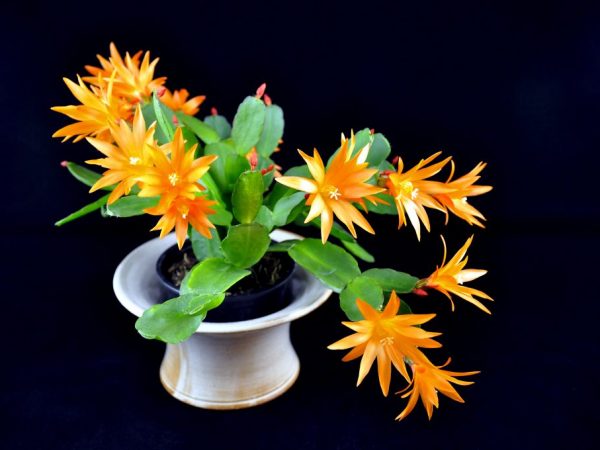
Hatiora - home care rules
Description of the plant
Botanical name - Hatiora, belongs to the Cactus family. Description of perennial shrub:
- a branchy plant in the form of a bush, consists of a large number of green jointed shoots;
- depending on the variety, the stems are cylindrical, flat or club-shaped;
- inflorescences of a reddish, yellow or white tone develop on the tops, the diameter of the flowers is 6-7 cm;
- in the wild, it occurs on tree trunks, in rock crevices;
- the bush is not high - 30-40 cm, the circumference is about 30-35 cm;
- the central conductor and adjacent skeletal branches in adult specimens are lignified with light brown bark.
Some scientists attribute the flower to the genus Ripsalis, but still they have differences:
- in ripsalis, inflorescences can form along the entire length of the shoots, have a snow-white or pale yellow color;
- different direction of growth of the stems - in the hatior they grow upward, and in the ripsalis - drooping.
These are the most important differences, otherwise they are similar in appearance and require the same conditions for development.
Varieties
An indoor plant has several subspecies that differ in color and size. After reading the name and detailed description, you will learn how to easily distinguish between them.
Saline
Botanical name - hatiora salicornioides. It has several names - saltwort, salicorniform, salicoroid. Due to the dense branching, the plant takes on a tree-like crown at maturity. Height - 40-50 cm.
It differs from other varieties in thin, cylindrical shoots, consisting of pin-shaped segments. The British call this variety the drunkard's dream.
In the middle of spring, salicata hatiora produces a large number of bright pink, red or yellow inflorescences. The bell-shaped flowers reach a diameter of 6-7 cm.
Pink
The name in Latin is hatiora rosea. Unlike the previous variety, this variety has flat reddish-green stems of two types - clavate or elliptical. Shoots are fleshy, emerald green with a smooth surface.
Inflorescences reach 3-4 cm in diameter. The color is pink, in the center there are thin lilac shades of villi, surrounded by a small flower of pale pink needle-like petals.
Hermine
The Latin name is hatiora herminiae.It has arched or erect shoots, about 30-35 cm high. The shape of the segments is cylindrical, the color is dark green. The length of each segment is 2-5 cm.
Hatiora blooms with crimson inflorescences with a circumference of 5-6 cm.
Gertner
Stems are segmented, green with a smooth surface. The length of each segment is 6-7 cm, containing small notches along the edge.
The inflorescences of the Gartner variety have a deep red color in the form of funnels, reaching a diameter of 5-6 cm.
Grezer
This hybrid form was obtained from two varieties - pink and gärtner. The stems are fleshy, formed from flat segments, 6-7 cm long.
It blooms with red or burgundy inflorescences, consisting of many elongated petals, a circumference of 5-6 cm.
Five-winged
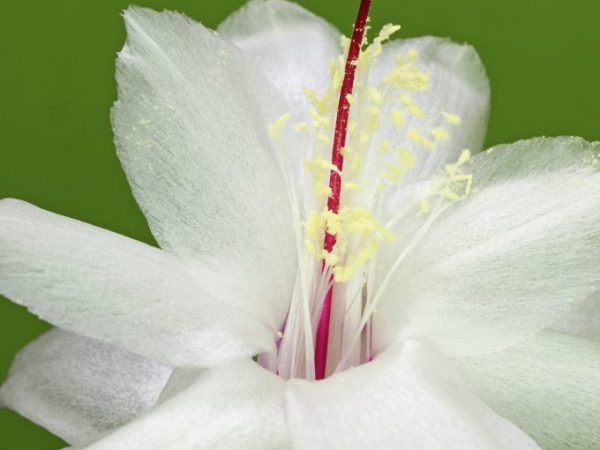
The color of the flowers varies depending on the variety.
A plant with pentahedral shoots of a light green hue, densely covered with snow-white inflorescences along its entire length. The flowers are small, 3-4 cm in diameter, consist of 6-7 petals, turned outward. There are thin villi in the center.
Epiphylloides bradei
One of the rarest and most decorative varieties bred by foreign breeders. The plant is distinguished by dense branching - drooping stems, consist of triangular segments 3-4 cm long. The color of the shoots, depending on the variety, is red, scarlet, purple, at the base the stems are green.
Hatiora epiphylloides produces beautiful yellow flowers. Buds are formed at the tips of the shoots.
Purchase and adaptation
You can buy one of the varieties of hatiora described above at any flower shop. The price, depending on the type, varies from 250 to 850 rubles.
Buy grown specimens with a well-developed root system and aerial part. When choosing a flower for your home, carefully examine the crown - the stems and inflorescences should be fresh, juicy, without blackening, reddish or yellow spots.
With light shaking off, you can determine its freshness - in healthy shoots, they do not break off and do not crumble. The substrate is slightly damp, does not contain acidification and mold on the surface. Through the drainage holes, you can see the roots - they are of a uniform brown shade without decay.
After purchase, it takes some time to adapt to home conditions. He is placed in a three-week quarantine, then transferred to the common room, placed among the vegetation.
If the hatiora is infected with some kind of infection, it is treated with fungicides, if it is affected by parasites, it is sprayed with insecticides. Only a week after the treatment, they are moved to the windowsill with other flowers.
Landing
Usually this procedure is carried out in the spring. Use a soil mixture for cacti or succulents, or a self-prepared substrate.
For a hatiory, it is better to take a wide and not too deep container, since it has a superficial and branched root system.
Use a pot made of plastic, ceramic with drainage holes at the bottom. Pour one handful of pebbles or expanded clay to ensure a good outflow of moisture. The pot is half filled with a substrate, the roots are lowered, straightened, sprinkled with soil to the top, compacted and watered.
Site and soil selection
To plant this color, you will need a light and loose substrate enriched with organic matter. You can use the mixture for planting cacti or succulent plants. You can also prepare the soil mixture yourself - mix peat with sand and turf in a ratio of 1: 0.5: 1.
The best place to contain is the southwest or west side of the house, where there is good diffused lighting. If grown in a south window, shade will be required at midday to avoid scalding the stems.
Do not keep the flower in the northern part, otherwise it will turn pale, grow slowly and may not bloom.
The necessary conditions
Humidity
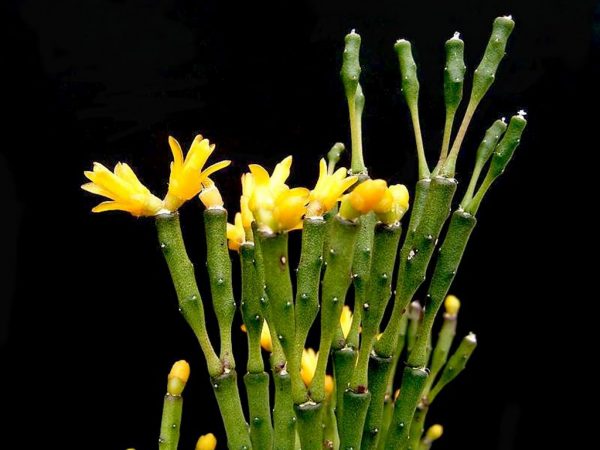
The plant is demanding on moisture
Prefers high air humidity - 75-80%.In the summer, irrigate every day with warm water from a spray bottle; on hot days, this procedure is carried out twice a day. Additionally, an open container with water is installed and the flower pot is placed on a pallet with wet pebbles or expanded clay.
In the cold season, you can arrange daily ventilation of the room, since the plant does not like stagnant air. Before opening the window, it is better to take the hathiora to another room, since from frequent drafts it can wither and discard the stems.
Temperature
Throughout the growing season, the plant is provided with a temperature in the range of 19-25 ° C. In summer, it can be kept on a terrace, balcony, where there is shade at midday and there are no drafts. You can also place the flower in the garden under shrubs or trees that create shade in the sun.
Inflorescences are laid in the winter season. For this process to be successful, you need to lower the temperature to 12-14 ° C. Abundant flowering begins in late April or early May.
Lighting
This is a plant of short light - 3-4 hours of diffused lighting per day is enough. This condition must be ensured in the spring and summer period. In autumn and winter, when buds begin to form, the flower can be placed in a place where the sun shines throughout the day. If this is not possible, you can use artificial lighting by installing the lamp at a distance of 50 cm from the crown.
Care features
Caring for this succulent at home is not very difficult, so anyone, even a novice florist, can grow it.
Top dressing
Regular and balanced nutrition provides the flower with decorative effect throughout the year.
Fertilizers are applied during the period of active growth and in the flowering phase. Mineral feeds with a low nitrogen content and no calcium are used.
The optimal proportions are phosphorus 18 g, nitrogen - 9 g, potassium - 24 g. The dry components are dissolved in water according to the instructions.
They are introduced according to the following scheme - once every 14 days, then watering is carried out in order to improve the quality of absorption of nutrients. In the resting phase, when the indoor succulent has shed its last buds, it is stopped feeding.
Watering
This plant loves regular, but moderate watering, so it is moistened only as the soil dries to a depth of 4-5 cm. They use settled or filtered water at room temperature.
In the winter season, the frequency is reduced to once every three weeks. After each watering, when the soil absorbs moisture, the liquid accumulated in the pan is drained. It is better not to add to the hathior than to pour it over. From frequent waterlogging, the root system suffers and quickly decays.
The next day, surface loosening is carried out so that the soil remains light and passes moisture well in the future.
Transfer
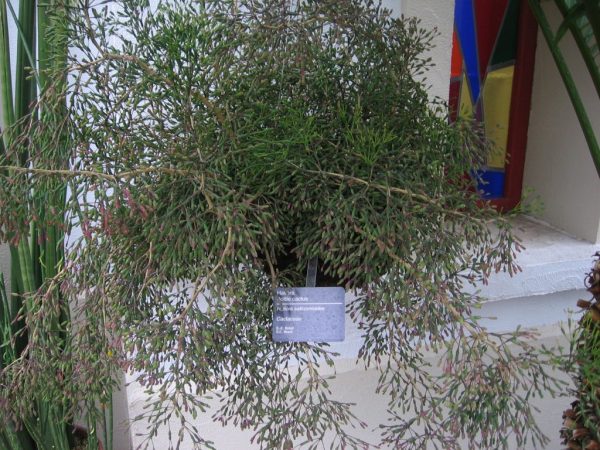
The flower can be transplanted in the dormant stage.
Flowers purchased at the store cannot be kept in the purchased land for a long time. It does not contain nutrients and over time the plants can wither away. It is not recommended to transplant a blooming hathiora, as it may not survive stress and will die.
After waiting for the end of flowering, they take a container 2-3 cm in diameter larger than the previous one, fill it with drainage, then with fertile soil used when planting a third of the volume.
The flower is watered abundantly in order to facilitate the extraction procedure and prevent injury to the roots, moved by the transshipment method, and then the soil is poured to the top, tamped and watered.
At home, the procedure is carried out every three years. An unscheduled transplant is required for a specimen whose root system has rotted or has been affected by harmful insects and diseases.
Pruning
Basic home care for a decorative cactus includes a yearly haircut. This plant can be given a beautiful appearance and density with regular pruning in the spring. The formation of the bush consists in pinching off the extra segments on the stems.
Some growers create a bonsai-shaped crown. This method is suitable for flowers with erect shoots. In early spring, the adjacent branches are removed from the lower part of the central trunk, gradually rising to the top. The upper stems are pinched to stimulate the formation of new processes.
To avoid infection, sprinkle with a fungicide after each pinching.
A sanitary haircut is also required in the spring: all dubious ones are cut off - yellowed, dry or decayed organs. At the end of flowering, dried inflorescences are cut off.
Flowering period
Many growers who grow this plant face a problem when it does not bloom or forms a small number of inflorescences.
There are two reasons for this - improper care during the rest period or too tight a container. In the cold season, you need to keep it cool (temperature 10-16 ° C), exclude all fertilizing and water every three weeks.
Subject to these rules, the Decembrist will delight you with lush and bright flowering.
Reproduction methods
Cuttings
Reproduction by cuttings almost always gives a positive result. After flowering, the apical shoot, consisting of 2-3 segments, is unscrewed, then, without rooting in water, it is planted in a nutrient substrate used when planting adult flowers, watered.
For rapid growth of the root system and green mass, the seedling is placed in a warm and well-lit place, regularly moistened.
Reproduction by cuttings makes it possible to obtain new bushes with all the varietal characteristics of the mother flower.
Vaccination
Usually, prickly pereskiy is used for grafting. The procedure is carried out in the summer. In places where it branches, the rootstock is cut, split. As a scion, a stem of a hatior of 2-3 members is used. A wedge-shaped cut is made in the lower part, then inserted in this place into the split, fixed with a plaster.
Remove the bandage after the scion begins to grow. Usually, engraftment and growth begins in 2-3 weeks at a temperature of 20-25 ° C.
This method of reproduction makes it possible to get abundantly flowering bushes.
By dividing the bush
The indoor flower is successfully propagated by dividing the rhizome. It is used if you need to plant and rejuvenate an old specimen or transplant a plant with rotten roots. It is watered abundantly, removed from the container, dipped in a basin of water to wash off the remains of the soil.
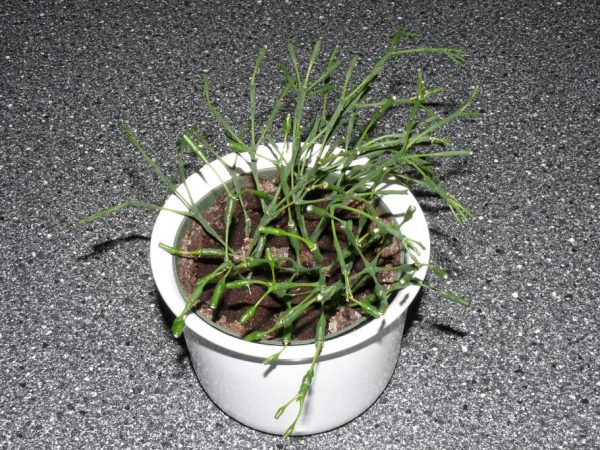
The flower is easy to propagate
All damaged areas are cut to a healthy tissue, the root system is divided using a sterile and sharp instrument. Each delenka should have several roots and one stem. Places of cuts are treated with charcoal, dried, then seated separately in pots. You can root the cuttings in the substrate used for planting adult flowers.
Hatiora can be propagated with seeds, however, this is a troublesome business and requires a lot of patience. In addition, seedlings need to provide the most comfortable conditions for germination, it is very difficult to do this at home. Therefore, flower growers rarely resort to this method.
Diseases and pests
Throughout the year, this plant can be damaged by various infections and parasites, if timely measures are not taken, it can die.
| Diseases and pests | Signs | Treatment | Prophylaxis |
| Phytophthora and Pithium | The cause of infection is planting in infected soil. First of all, the root part of the stems suffers, at an advanced stage, the flower massively discards its limbs, withers, the entire above-ground part takes on a pale gray tint | Used for spraying the soil and crown Skor (1 ml per liter of water), Topaz (2 ml per 10 liters of water), Maxim (5 drops per 200 ml of water), Vitaros (2 ml is dissolved in 2 liters of water, treated twice with an interval of 10 days) | Use a sterile planting and transplanting substrate |
| Late blight | Fungal infection penetrates the tissues through wounds and soil, causes rotting of the root system and neck.Later, the hatiora withers, the aerial part crumbles | Not subject to treatment. The diseased plant is disposed of | In spring and autumn, the crown is sprayed with preparations - Bayleton and Mikon |
| Bacterial lesion | A dark, watery, slippery spot appears at the bottom of the crown. Without timely treatment, the bacterium begins to rapidly cover the entire part of the stem. | At the initial stage, antibacterial drugs are used (Phytocide or Fitosporin). At the advanced stage, the apical shoots are cut off for further rooting, and the old bush is disposed of | Avoid waterlogging, plant the flower in sterile soil |
| Spider mite | A small insect appears in conditions of high temperature and low humidity. Cobwebs envelops stems, internodes, feeds on their juice. The affected areas turn brown, die off | Crown processing with Neoron, Fitoverm or Aktellik | Lower the temperature and increase the humidity in the room |
| Mealybug | White sticky mucus on the surface of the shoots is a sign of the appearance of this parasite. It sucks the juices from all aboveground organs, which leads to their wilting and falling off. | Spray with Aktara or Confidor. 2 ml of the drug per 200 ml of water. After a week, re-process | Water regularly, remove affected areas in time, use sterile soil mixture for planting and transplanting |
| Shield, false shield | Insects in the form of red or brown plaques stick to the surface of the stems and feed on their sap. Damaged spots darken, rot and die off | With the help of a cotton pad dipped in Karbofos or Tanker, remove parasites along with plaque. Then carry out the treatment of the soil and crown with a solution of laundry soap - 40 g per 1 liter of water | Provide bright diffused light, increase humidity to the desired level, plant in disinfected soil |
Signs and superstitions
This plant with an unusual appearance has received many names among the people - a drunkard's dream, men's tears, dancing bones.
Some growers do not risk growing it, because they believe that it can drive any man out of the house, or harm existing relationships - provoke misunderstandings, quarrels, scandals and divorce.
Other superstitions claim that hatiora helps you identify an enemy who is visiting your home. Some time after his departure, she blooms. This is a sure sign that communication with such a person should be minimized.
The benefits of a flower are expressed in the ability to act soothingly for all family members, to establish the former atmosphere and comfort. If you accept a flowering plant as a gift, then peace and harmony will reign in your home.

